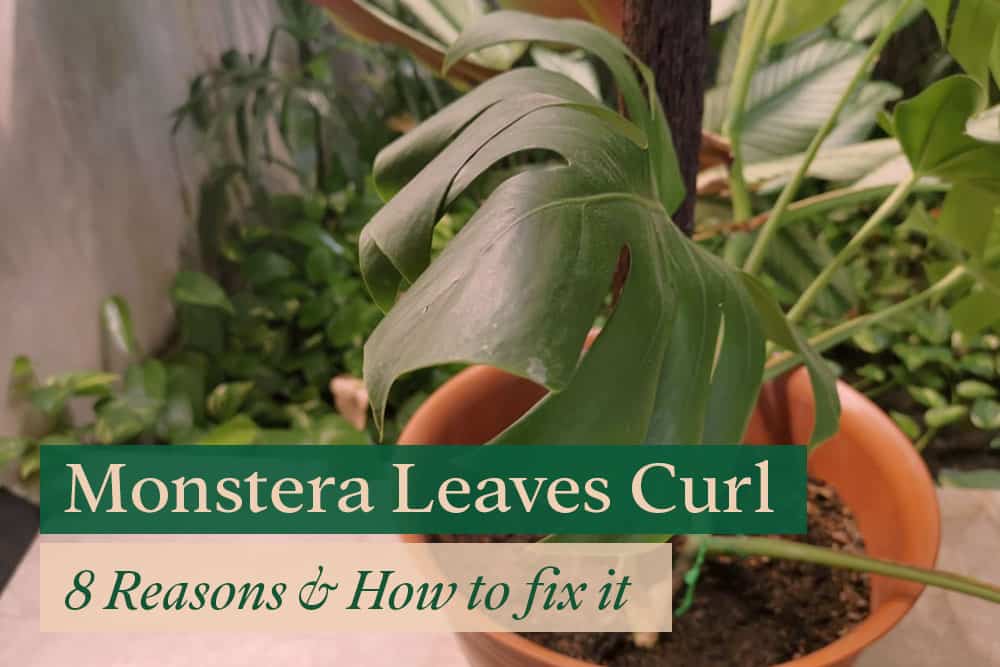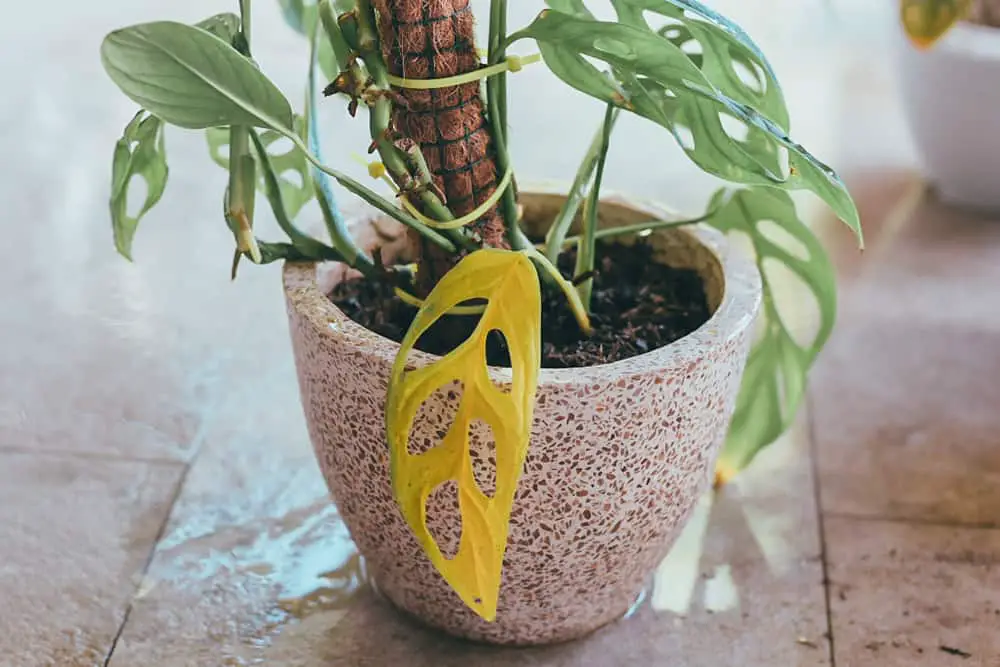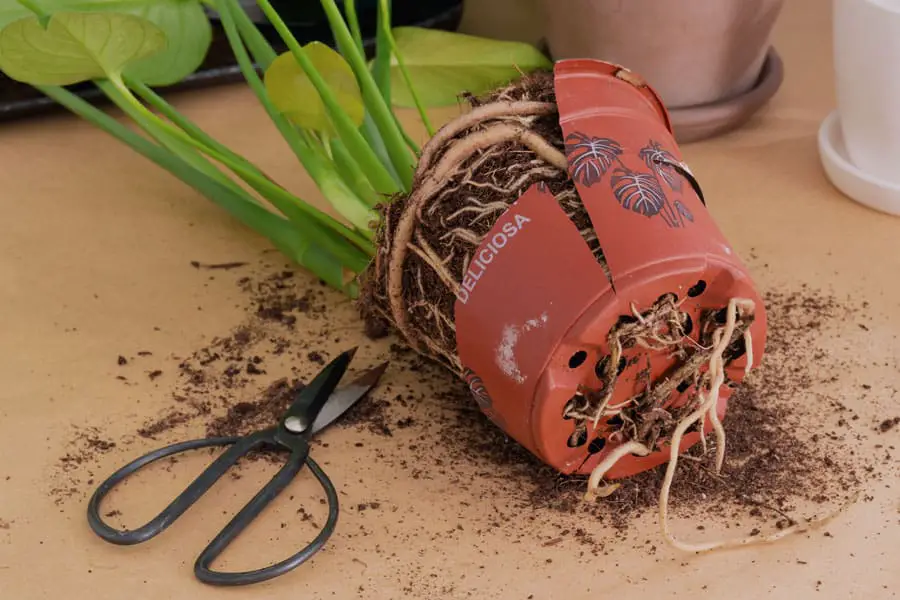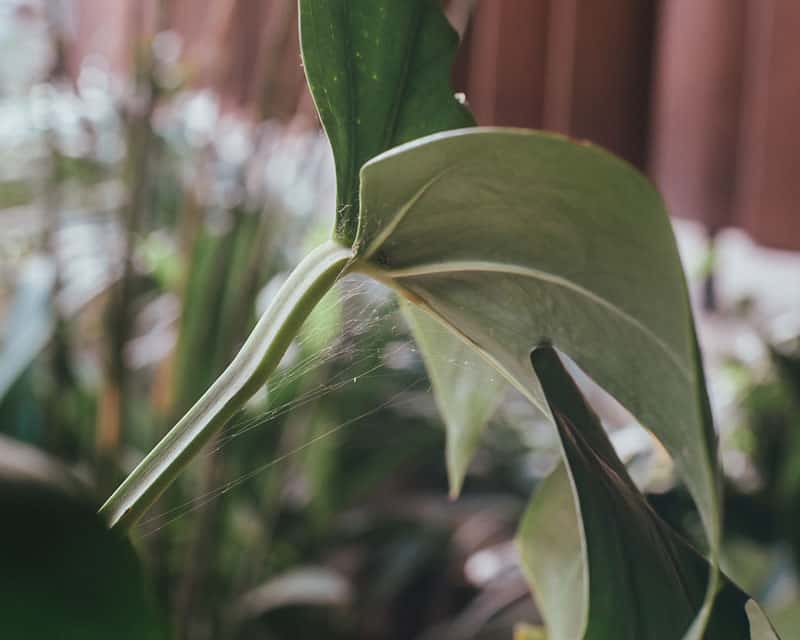
Do you find your Monstera leaves curling up? Well, there may be a number of reasons why monstera leaves are curling up.
Monstera leaves have been known to curl up as a defense mechanism in response to insufficient water absorption. This is a natural adaptive measure but also shows that the plant is in distress due to improper care or pest infestation.
In this post, I’ll go over each causes of monstera leaves curling and what you can do to fix them.
Let’s get started!
8 Causes of Monstera Leaf Curling:
Monsteras can curling up for a number of reasons, including:
- Underwatering
- Overwatering
- Use of chlorinated tap water
- Low humidity
- High temperature stress
- Over-fertilization
- Rootbound
- Pest Infestation
Underwatering
Do you remember when was the last time you watered your Monstera? Because one of the most common problems that cause your Monstera’s leaves to curl up is underwatering.
When Monstera is underwater, it activates its natural ability to preserve water loss. Monstera leaves curl up to reduce the surface area to avoid releasing too much water moisture into the air by transpiration.
How to check if the leaves curling is due to underwatering:
- Firstly, you should check if there are any other signs – such as drooping, crisping, or browning leaves on your Monstera.
- Another easy way to check for underwatered Monstera is checking the weight of the pot, keeping in mind that dry soil pots will feel much lighter than wet.
- You can also rely on modern technologies such as a single probe soil moisture meter to tell you when it’s time to water. Insert it about 1/2 to 2/3 of the way down from the surface. When the moisture level is below 3, it means you need to water immediately.
How to fix underwatered Monstera:
- Place your Monstera in a bathtub and soak the soil with plenty of water for a few minutes and let it sit a while until the water drain completely.
- If your Monstera is severely underwatered and shows signs of wilting, you might want to carefully relocate the plant into a bucket of water. This will give a chance for the plant to recover faster.
Also read: Monstera Water Requirements: How often should you water a Monstera?
Overwatering
You have watered your Monstera every day, but the leaves still curl up. Well, in this case, you might be causing the leaves to curl by overwatering instead.
Overwatering will drown the roots of your monstera, which can lead to fungal diseases, such as root rot. When the root system is damaged, it will not be able to transport nutrients and water for the rest of the plant.
As in the case of underwatered plants, Monstera leaves tend to fold themselves up as a response to water deprivation and reduce the amount of water vapor released into the air.

How to check if the leaves curling is due to overwatering:
- Finger test: Insert your finger into the soil. If it feels wet 2 to 3 inches down, wait for a few more days before watering again.
- Poke a stick method: Stick a wooden chopstick or dowel into the soil. If it comes out moist with bits of dark soil stuck to it, it’s not time to water yet.
- Meter soil: Insert the probe into the soil about halfway down into the pot. When the meter still reads above a 3, you do not need to water the plant.
How to fix overwatered Monstera:
- When my Monstera leaves start curling up, I just wait for a few days to let the soil dry up before giving it water again.
- If the soil didn’t dry in time, you might need to improve your drainage holes or replace the soil with aerated well-draining soil to prevent future curling. Try adding orchid bark, coconut coir, and perlite to your potting soil mix.
Use of Chlorinated Tap Water
If you water your plant on a set schedule and haven’t over-or under-watered it, then you might want to check the water quality you are currently using.
Tap water comes with chlorine and fluoride, which are added to help stop the spread of germs. These chemicals will kill off beneficial microbes living within your soil, preventing them from decomposing organic material and making it available for your roots to absorb.
In addition, extensive use of tap water accumulates the salt build-up which will kill your Monstera’s root tips and make them more susceptible to root rot.
And again, the defense mechanism is triggered due to a lack of water and nutrients. That will result in your Monstera’s leaves curling up.
How to fix the leaves curl caused by the use of tap water:
- Check the roots for black, rotten ones and trim them off.
- Repot your plant in a new well-draining, aerated soil mix that is appropriate for Monstera.
- Let the tap water sit out for at least 24 hours, this will evaporate the chlorine from the water. Alternatively, you should use filtered or rainwater instead.
Low Humidity
You might remember those science lessons from high school that showed water vapor moving from regions with high humidity to regions with lower humidity. But what does this have to do with Monstera leaves?
As I mentioned earlier, plants release water through transpiration. When the humidity in a room is low, leaves on monstera plants will lose more water than normal and start to curl up.
How to check if the leaves curling is due to low humidity:
- Curling Monstera leaves due to low humidity can often be mistaken for underwatering. Signs such as drooping, browning, or crisping leaves on your plant are also common indicators of low humidity.
- To diagnose the problem correctly, you will need to buy a hygrometer.
Fixing the leaves curl caused by low humidity:
- To prevent curling leaves, Monstera should ideally be placed in a room with humidity levels between 40% – 60%.
- If your room humidity level is below 40%, you should either get a humidifier, pebble tray or try grouping your houseplants together to increase overall humidity.
Temperature Stress
Plant leaves may curl up because they are transpiring at higher rates due to increased temperatures. At 30°C, a leaf may release water moisture three times as fast as it would at 20°C.
Monstera leaves are also likely to be affected by sudden changes in room temperature. When you move it from a cool air-conditioned room to a warm outdoor environment, Monstera will show signs of heat stress within the first few hours.
How to check if the leaves curling is due to high temperature:
- Immediately check your room temperature. Ideally, Monstera should be placed in a room temperature between 65°F-85°F (18°C-30°C).
- Direct sunlight can lead to sunburn to your Monstera leaves and cause the leaves tips to turn brown and curl inward.
How to fix curling Monstera leaves caused by heat stress:
- You can prevent Monstera leaves from curling up by placing the plant in a room with year-round, moderate temperatures and away from direct sunlight.
- While Monstera is tolerant of lower levels of light, it will often grow leggy as a result. An ideal location for it would be in indirect bright, filtered light from east-south facing windows.
Over-fertilization
Excessively fertilized soil can lead to an accumulation of fertilizer salts, affecting the PH of your soil. This will lead to severe root damage which prevents nutrients and water from being absorbed.
And, as you know, if your Monstera doesn’t get enough water it will curl its leaves in an attempt to lower the transpiration rate.
How to check if leaves curling are due to over fertilization:
- Over-fertilizing will cause crusty build-up on the edges of your pot or even on the surface of the soil.
- Yellowing of lower leaves, browning and crispy leaf tips and even defoliation is common signs of over-fertilizing.
- Lastly, you can inspect the roots, if the roots are burned and damage then it is most likely due to over-fertilization.
How to fix over-fertilization in Monstera:
- You can fix an over-fertilized Monstera plant that started to curl up by trimming any badly burned or damaged roots and repotting it into fresh well-draining soil and pot. Do not re-use the old pot as the build-up salts are difficult to remove.
- Be sure to always fertilize at half the recommended dose.
Rootbound

Monstera leaves might curl because they have grown too big for their container. Healthy growth can lead to a plant with a root system that is much bigger than the pot it’s currently in and must be transplanted at some point.
Roots that are root-bound don’t hold onto the soil, which means they can’t retain any water for timely absorption.
How to identify root bound:
- If you see roots are poking through drainage holes at the bottom of the pot, then it’s highly probable that your Monstera might be root-bound.
- To check on the root ball, it is best to slide the entire plant out of its container.
How to fix leave curls due to root-bound:
- Improving the soil by repotting it into a 1 to 2 inches larger container will give its roots more space to grow, allowing for better absorption of moisture and nutrients. You should repot regularly every 2 to 3 years.
Insect Infestation
Along with all of the care we might do wrongly, there is another natural cause why Monstera leaves might curl up. Insects!
The most common sap-sucking insects that you may encounter on your monstera are spider mites, aphids, and thrips. They feed on the nutrient rich sap from your Monstera leaves, causing them to curl.
You need to kill these insects as soon as possible or your plant will die quickly.
How to check if you have pest infestation on your Monstera:
- Wiping your Monstera leaves regularly with a damp cloth can help you identify pests early.
- Changes in leaf color and texture can signify an insect problem. These pests can cause the leaves to turn spotted, speckled or yellowed.
- Insect droppings and webbing along the underside of leaves, stems, or both are common signs of insect infestation.

How to quickly exterminate pest infestation:
- Spider mites, aphids, thrips, and white flies can be dealt with using non-chemical methods such as dishwashing liquid soap or rubbing alcohol.
- In severe cases of infestation, you’ll need to use chemical solutions or remove the afflicted plant before it spreads.
- Using neem oil is one of the best ways to prevent infestation.
The Different Type of Curl: New Leaf Growth
A new Monstera leaf may curl for a short period of time when it first appears but the leaves will eventually unfurl if you left them to rest.
Furled monstera leaves are very delicate and should never be unfurled by hand. Doing so can cause brown spots or stunted growth for the new plant.
In conclusion
The most common reason for leaf curl in Monstera is not adequate water intake. This triggers the plant to think that it’s dying from underwatering and shrinking its leaves surface to avoid further transpiration.
Keep in mind that curling leaves could be a sign of improper care on your part or an insect infestation.
I hope this article helps you determine the reason for your monstera leaves curl.
